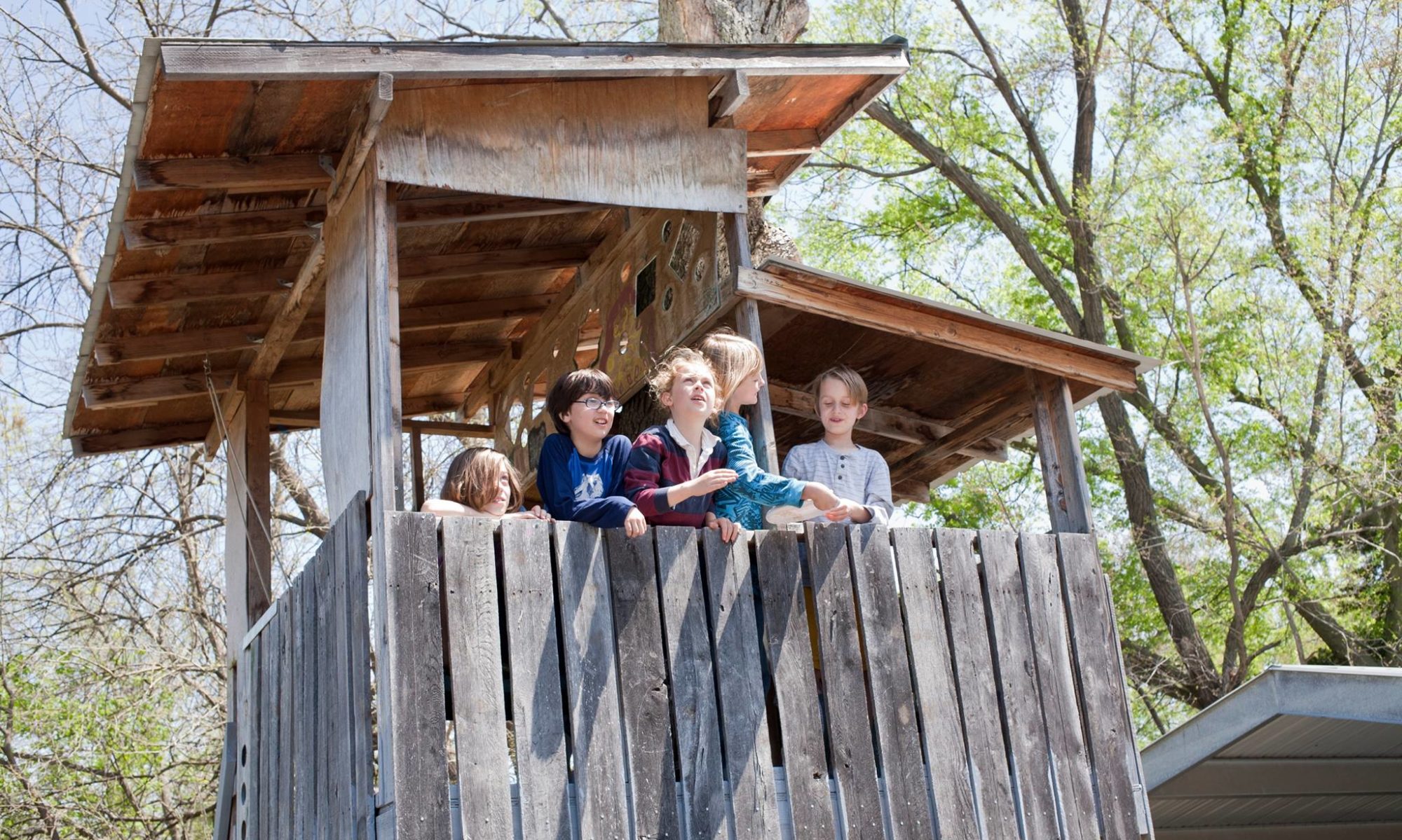A brief history of the Delaware Street Commons cohousing project.
Cohousing in Lawrence
Delaware Street Commons began at the Cohousing Network Conference in 1999. After attending that conference, Steve Polson and Margie Wholey advertised a meeting for cohousing in Lawrence. On November 9th, 1999, thirty people attended the meeting at the Watkins Museum. By January 2000, the group was meeting regularly and starting to organize the project. The group reached agreement on its structure and goals in April.
In May 2000, Chris Scott-Hanson of Cohousing Resources was hired as project manager, and marketing activities grew to include video work for a half-hour show on the local cable channel, and a table at the Smart Growth conference. Concern for enhancing the budding community lead to the start of Meeting of the Heart. The legal shape of the cohousing group emerged in June with the creation of the Lawrence Cohousing LC to handle the investment side of the development.
July saw the first major milestone achieved with the site selection. In a single weekend, his first visit, Chris Scott-Hanson spoke to over fifty people at the Lawrence Public Library, toured eight sites (out of twenty possibilities), and after the group’s decision started negotiations to purchase the 3.3-acre site at Delaware Street in old east Lawrence. The decision to make a formal offer was made at the July 22nd business meeting, while a subsequent decision was made to lease the McMillen House at 1208 Delaware.
We are the Delaware Street Commons
By September of 2000, less than a year after the initial meeting, the cohousing group, now with the name Delaware Street Commons, was meeting on its chosen site, with four equity households and seven associate members. An Open House celebration of the group’s progress drew over 200 people. The next month, eight households participated in the first of three planned design workshops, the Site Design workshop run by Katie McCamant. Work began in late October on the zoning variance that would be required to build the multifamily units intended for the project, working with Peridian Engineering. By the first anniversary, the project had grown to five equity households and eight associates.
Half a year after selecting the site on which the project would be built, the zoning request was approved by the City Commission on January 2, 2001. The project continued to add equity and associate
Crisis
Delaware Street Commons ran into its first major hurdle in late May, when one equity household, who had been major contributors for both time and money, announced that they were withdrawing from the group. The remaining members were faced with a daunting set of questions keying off one main concern: can DSC keep going?
After a grueling series of meetings, totaling fourteen hours in a single week, the active members agreed to keep together and keep searching for a way to finance the land purchase. Two new equity members joined during this period, bringing the total (active and inactive) equity membership to eleven. In May, the group was talking to four banks. By July, all of these banks had decided that they were not interested in loaning the group the money required to purchase the land. Finally, Lawrence Bank stepped forward and offered to make a loan equal to 80% of the land’s appraised value: but it was not willing to make a loan to the group as a whole (the DSC Limited Company). Finally, after much discussion, a new, small LC was formed, composed of the three equity members who had sufficient assets to satisfy the bank’s requirements. This group quickly became nicknamed the “Little LC.” With some additional investment funds from a couple of individuals outside the group, by the end of
Landowners
On August 9th, the papers were signed and the “Little LC” took title to the land. With this milestone reached, attention turned to the budget and planning for the Open House to celebrate the land purchase, which was held in late September. Delaware Street Commons owned 3.3 acres of land, owed hundreds of thousands of dollars to the bank, and was now responsible for maintaining three houses, (one which was subdivided into three apartments), and renting two of them. For the next year and a half, the property management aspect of the project would take up far more time and resources than anyone anticipated. There were worse problems, however: lack of growth, and lack of money.
Stalled
Two equity members were added in the fall of 2001, but then the membership stalled. Existing associate members, for the most part, left or drifted away. A few new associate members joined, but the membership growth was effectively zero. ‘Burn-out’ and changing circumstances would lead, over the next year, to several equity members dropping out of any active role in the project.
The land purchase strained the group’s financial resources to the limits, leaving Delaware Street Commons with no reserves with which to invest in either marketing or project design. Within months of the purchase, the group chose to end the contracts with Chris ScottHanson and Neshama Abraham for
Despite the stalled membership, Delaware Street Commons managed to plan and hold the last of the three original workshops in May of 2002. The workshop was led by the project’s architect, Kirk Gastinger. At this workshop, the four-bedroom townhouse was dropped from the site mix, and a three-bedroom flat added.
Downsizing
Closing on the land purchase was barely achieved before the possibility of downsizing the project was raised. The discussion would begin in October of 2001 and continue well into 2002. Finally, the group decided to downsize from 32 units to around 22 units. It also decided to sell part of the land, including the McMillen House, discarding the plan to use that a common house, because of renovation costs and its lack of centrality to the main section of the site.
After further weeks of discussion, the group chose to sell the north 1.1 acres of land, subdivided into two lots, one of which would be zoned for multifamily construction (4-5 units), the other containing the McMillen House. Peridian Group was again hired to create the new site drawings and work with us to get city approval of the changes. By the end of 2002, we had the changes in
The north lot was sold to Tenants To Homeowners, Inc., a Lawrence city organization that develops subsidized housing. This sale was important to a number of members, as it helped meet the desired goal of making lower-cost housing available to potential members. We were not able to devise a way to included subsidized housing within the project, but the public access easements in the subdivided lots were designed with the intent of making it easy for people living in the north lot to join Delaware Street Commons as associate members and participate in shared activities.
The McMillen House was sold to a couple who are currently associate members, who plan to renovate the house, possibly as use for a guest house or other adjunct to the Delaware Street Commons.
Moving Forward with Design and Marketing
By the spring of 2003, the sale of the two lots had been accomplished, leaving the group with 2.2 acres of land. The fortuitous circumstance of an increased value of the land allowed the group to retain all of the money from the sales while continuing monthly payments on the land loan. With money in hand, Delaware Street Commons cleared its debts, and began to move forward in design and marketing. A half-day workshop with the architect was held in mid-May of 2003, discussing the design criteria for a new-construction Common House, and criteria for the integrated design discussed. Neshama Abraham was rehired as a marketing professional, and a local management company hired to handle the rentals.
Summer and Fall of 2003 were taken up with working out the floor plans for the individual units and the common house with the architect. More of the detailed work of the group began to be conducted by smaller teams, leading to shorter general meetings
Money Matters
In December of 2003, the group selected Neighbors Construction Company, Inc. as general contractor. In early 2004, the group worked with the architect to get city approval on the modified Preliminary Development Plan and the Final Development
Early in 2005, the group began working with First State Bank to assemble a financing package. With the help of friends, philanthropists and a bridge loan from a cohousing credit union, the group was able to secure a loan. The loan was approved in December of 2005 and finally signed by six households at the end of May 2006.
Construction!
After so much time and effort, the group was thrilled to see construction begin in August of 2006. The work went quite quickly and most of the houses were enclosed before the first snow. Spring 2007 brought

